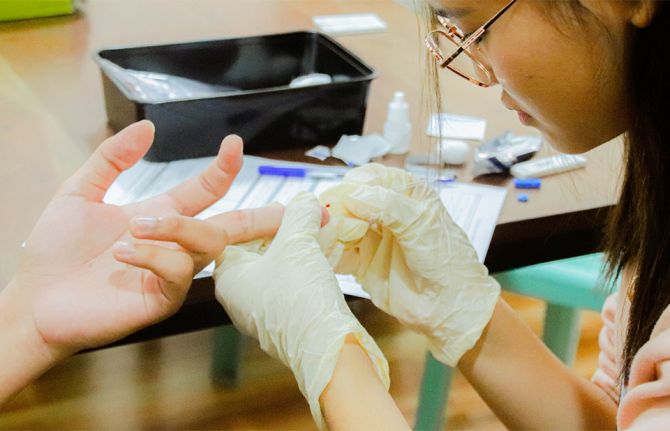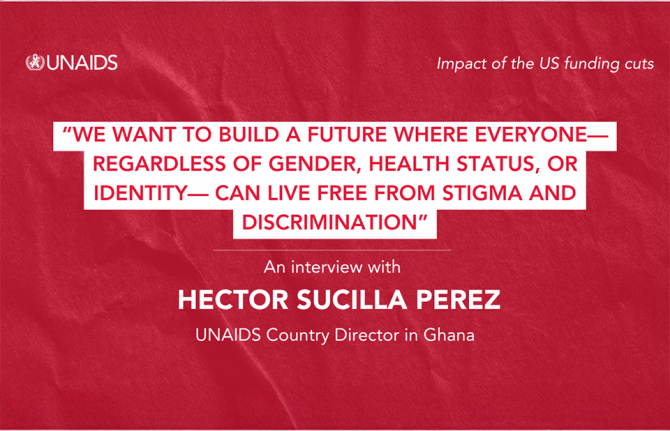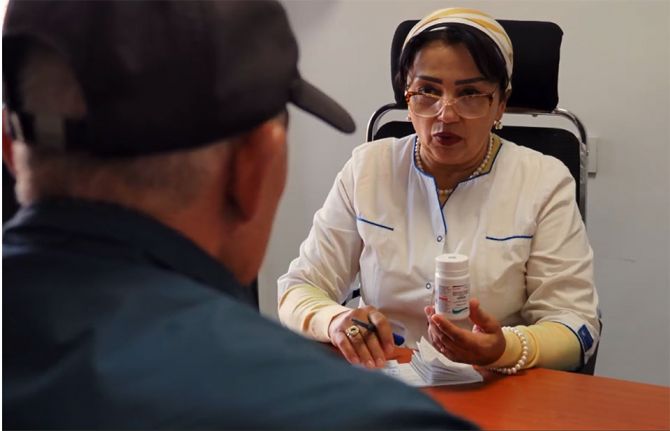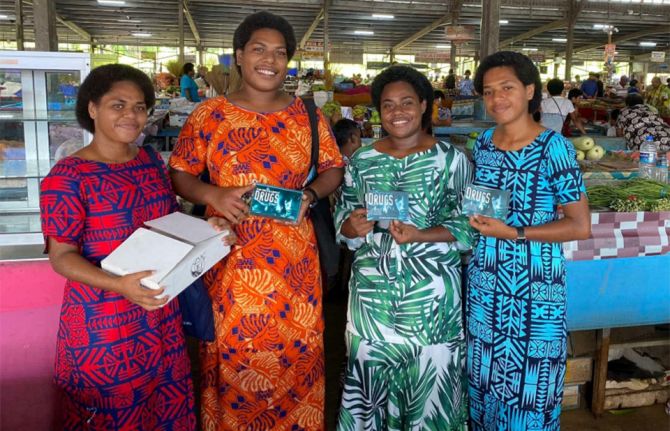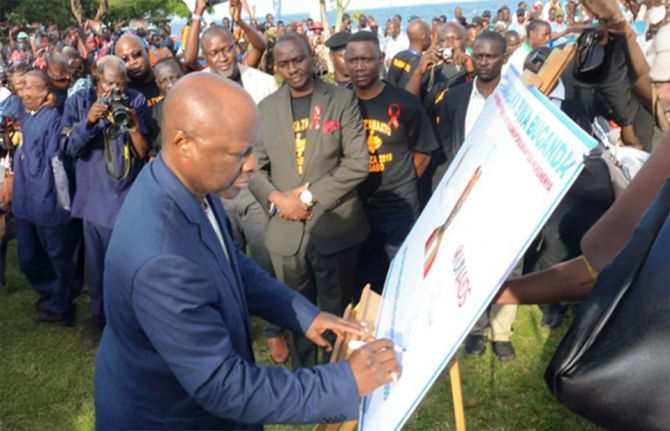
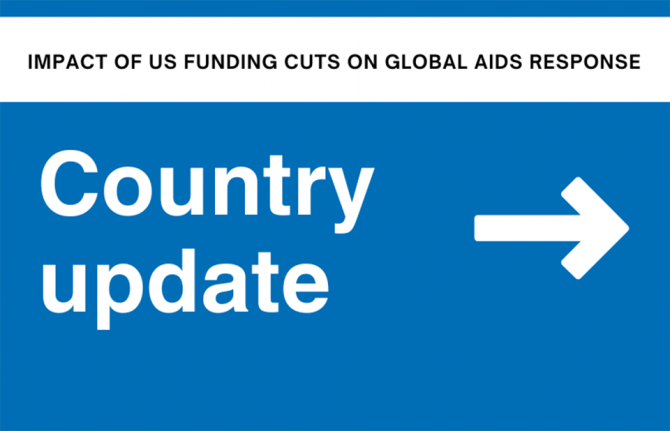
Feature Story
Impact of US funding cuts on HIV programmes in Nigeria
27 March 2025
27 March 2025 27 March 2025Stock Levels and Immediate Risks
- Stock Levels: A recent national stock-level assessment indicates that there are at least two months of stock at facilities and five months at central warehouses. This is consistent with normal operations, and no immediate risk of stockouts is anticipated. New shipments are expected in April.
- Service Disruptions: Some communities-based service delivery points are facing serious service interruptions, and there are currently no plans for referrals to other facilities. . Community HIV testing for the general population and key populations (KPs) has been significantly impacted due to disruptions in the community health workforce. Specialized wraparound services at over 80 One-Stop Shops have been disrupted in one way or another due to funding freezes. Disruptions in services for orphans and vulnerable children (OVC) may impact children living with HIV.
Relevant Updates
- Government Actions: The Nigerian government has taken proactive steps to address potential AIDS funding gaps, particularly in response to the suspension of US-funded programs. The Federal Executive Council (FEC) has approved N4.8 billion for procuring 150,000 HIV treatment packs under the 2024/2025 HIV Program Alignment. The government is also strengthening national systems, securing local financing, and engaging the private sector, including plans to establish an AIDS Trust Fund.
- Healthcare Workforce: The Government is collecting information about the health care workers that have been impacted by the funding freeze, with the intention to determine the critical number and skillset of workers in each state to be recommended for absorption into the public health workforce. One of the states, Rivers State, recently recruited 1,000 healthcare workers, absorbing some who were affected by the funding freeze. The Network of people living with HIV is leading efforts to map the impact on the community health workforce, with a Ministerial Task Team reviewing findings and proposing state-level interventions.
- Community and Civil Society Response: Community-led and peer-led services is mostly supported through the Global Fund and has continued, those PEPFAR-funded components have been interrupted due to "stop-work" orders issued to PEPFAR Implementing Partners. Many partners have yet to communicate updates to community workers, despite directives in the February 4th Memo from the US Government. Some implementing partners, such as Heartland Alliance, which supported over 20 One-Stop Shops for Key Populations, have received official contract termination notices from USAID, with no clear transition plan for their services.
- Resilience and Adaptation: Despite these challenges, the community and civil society organizations have shown resilience. For example, about two-thirds of community workers who received "stop-work" orders in January/Early February have been recalled following the February 4th Waiver Memo from GHSD. Additionally, national acceleration efforts to prevent vertical transmission of HIV continue to scale up across all states under Global Fund funding, relying on public health institutions and Global Fund-supported community health workers.
Summary of Key Assessment Findings
The task team has been meeting at the governmental level, with UNAIDS supporting the Federal Ministry of Health and the National AIDS Council DG, who co-chairs the task team.
Summary of key assessment findings:
- Community Workforce: Over 95% of community workers received "stop-work" orders, but about two-thirds have been recalled.
- ARV Access: Immediate access to antiretrovirals remains stable but testing and case-finding activities have stalled significantly. Investments by the Government of Nigeria and the Global Fund in the National PMTCT Acceleration Plan has however supported continued scale-up of PMTCT testing and treatment.
- ARV Stock Pipeline: The pipeline for 1st-line ARVs remains strong, with over six months of stock available. New shipments are expected to continue, but distribution challenges may arise.
Crisis Response Plan: The newly inaugurated AIDS, TB and Malaria TWG, has been tasked to leading the convening of critical stakeholders to set-up crisis response plans at national and sub-national level, with clear communications channels for reporting service delivery disruptions. The committee has conducted a preliminary gaps analysis which informed the approval of a supplementary budget of about $200 million.
Related resources
Region/country
Related


Feature Story
Impact of US funding cuts on HIV programmes in Malawi
27 March 2025
27 March 2025 27 March 2025Immediate Risks and Disruptions
A full resumption of HIV services is required for the effective delivery of HIV prevention services. HIV services are dependent, and different parts of the U.S. Government fund different components —for example, the Centers for Disease Control and Prevention funds HIV treatment - which received a partial waiver to continue - and USAID funds the supply chain. Partners funded by USAID received stop work orders, halting the flow of essential HIV treatment commodities and impacting the delivery of HIV treatment and prevention services. Partial waivers block the delivery of services.
The country has 37,000 vials of cabotegravir long acting injectables expiring in May 2026. A further 30,000 vials purchased under the Global Fund to Fight AIDS, Tuberculosis and Malaria will arrive in Malawi in June 2025 to support the scale-up of injectable PrEP. To absorb the gap in the program created by U.S. funding cuts to the partner supporting this activity, the government has instructed the remaining implementer to continue with the scaling up of injectable PrEP focusing on people continuing PrEP and only recruit new pregnant and lactating women. However, the absence of implementing partners and the limit to recruit only continuing clients and pregnant and lactating women may not generate sufficient the client load risking the long acting injectables expiring. A resumption of the program to recruit on the full spectrum of eligible people into the program is required.
- Human Resources:
- Contract Terminations: More than 4,500 staff including 247 nurses, 1,642 Health Diagnostic Assistants, 1,871 treatment supporters, data clerks and others supported by U.S. funding have had their contracts terminated. The exact numbers of staff impacted are difficult to quantify because of the stop-and -resume flow of human resources based on the stop-resume-stop implementation of the waivers.
- Reduced Capacity: Although the government of Malawi has rationalized the continuation of services and deployed staff to fill the gaps created by the stop order and waiver, HIV services are yet to recover fully. Facilities providing prevention of vertical transmission of HIV, early infant diagnosis (EID), pediatric and adult HIV treatment services are operating at reduced capacity. Community-led monitoring and other activities led by civil society have reduced. Only community-led activities supported by the GFATM are continuing, helping fill the gap in the availability of HIV services
- Outreach Services: Outreach services, especially those targeting key populations, adolescent girls and young women, refugees and displaced people, have been affected, impacting prevention and treatment services and may lead to increased antiretroviral therapy default rates and new HIV infection.
- Service Provision:
- Facility Closures: Some facilities providing Antiretroviral Therapy (ART), especially the 18 drop-in centers serving more than 7,000 key populations living with HIV have reduced their operations and referred the people to to other facilities. Crowds of patients waiting for services typical of non-HIV services are now common in the HIV treatment section.
- Testing Services: DNA-PCR testing for HIV Exposed Infants (HEI) will continue only at sites with point-of-care testing capacity. Other infants will be tested at 12 and 24 months using Rapid Diagnostic Tests (RDT).
- Targeted viral load sample testing will take place in sites with point-of-care capacity. new HIV infections, with poor EID service, new HIV infections among children are likely to increase.
- Supply chain and sample Transportation: The sample transportation system has been suspended. Although the government redeployed ambulances to transport samples, hundreds of thousands of samples remain stuck and unusable, A million HIV test kits risk expiring, without a revitalized HIV testing drive using local staff. Although implementing partners leading work on voluntary medical male circumcision (VMMC) received partial waivers to continue VMMC. Without a full resumption of the program, the VMMC faces an imminent stop in a month because the supplies are limited.
- Commodity Stock Levels:
- ARV Supplies: Stocks of antiretroviral (ARV) supplies, HIV, viral load (VL) and other lab test kits, and condoms are available with minimum disruption. However, dispensing of ARV emergency supplies has been suspended to avoid panic refills and depleting stocks.
- Condom Stock Levels: Sufficient for the next 12 months, but non-facility condom programming has stopped.
- Impact on Specific Populations:
- Adolescent Girls and Young Women (AGYW): Reduced capacity for HIV prevention services, including PrEP, testing, and outreach programs. Malawi has 2,341,000 AGYW of which 2.4% are living with HIV. 25% of new HIV infections are among AGYW. Programs for orphans and vulnerable children have completely stopped and are not included the prioritization of HIV services.
- Key Populations (KPs): HIV prevention services for KPs have also been impacted. This includes continuation of provision of oral PrEP where human resources are available, and continuation of only old clients on injectable PrEP. Discontinuation of hepatitis B testing except in antenatal care and inpatient care. The Government with implementing partners support 18 Drop-in Centers spread across in Blantyre, Mangochi, Muzuzu and Lilongwe are devising a plan to keep the dropping centres. The centres cater to key populations with a total cohort of 7,600 people living with HIV accessing HIV treatment and 7,000 continuing PrEP.
Politically Relevant Updates
- Government Actions:
- Task Team: A country-level task team has been convened to discuss the impact on service delivery and identify mitigation measures. This includes representatives from people living with HIV and key population networks.
- Mitigation actions by government and country partners include expanded community health worker or peer-led health services and integration of HIV services into other health services.
- Transitional Plan: The government is developing a plan for HIV commodities warehousing and distribution to transition from the current service provider to the Central Medical Stores Trust.
- Civil Society Impact:
- Community-Led Organizations (CLOs): CLOs are at risk of closure or severe reduction in services due to funding cuts. This affects their ability to deliver services, advocate for key issues, and participate in policy discussions.
Related resources
Region/country
Related


Feature Story
Impact of US funding cuts on HIV programmes in Eswatini
27 March 2025
27 March 2025 27 March 2025Current Challenges and Disruptions
- Decline in HIV Case Identification and Contact Tracing:
- Limited availability of HIV testing (including self-testing, workplace testing, and community-based approaches).
- As a result, of being unaware of their HIV status, pregnant women living with HIV may have compromised access to vital services to prevent vertical transmission of HIV.
- Due to limited access to testing, there has been a significant decline in HIV case identification, contact tracing efforts, and peer-based linkage, particularly among high-risk populations such as men and youth.
- Healthcare Worker Job Cuts:
- HIV Programme Officers have had - and others may have – there jobs cut. For those who have retained jobs, there is a proposal to align their salaries with government pay scales.
- This has affected the capacity of facilities/service points that provided antiretroviral therapy, leading to reduced availability of HIV testing and other services.
- Data collection at all facilities/service points continues, but data quality control and data collation are affected.
- Disruption in Distribution of Supplies:
- Distribution of antiretroviral supplies, HIV, viral load, and other lab test kits, and condoms is disrupted.
- Stockouts are foreseen in 3-6 months, although the country has sufficient condom stocks for the next 12 months.
- Impact on HIV Prevention Services:
- Primary HIV prevention services have been disrupted, including reduced availability of PrEP services, suspension or reduction of HIV prevention education and awareness campaigns, limited or suspended implementation of voluntary medical male circumcision services, and delays or disruptions in community-based HIV prevention outreach programmes.
- HIV prevention programmes for adolescent girls and young women (AGYW) have been impacted, affecting between 120,000 -150,000 AGYW. These include a reduced capacity of service delivery points for HIV prevention, delays in linkages to HIV prevention services, discontinuation of AGYW-specific outreach programmes, reduced availability of HIV prevention education and awareness campaigns, and a reduction in the availability of counselling and social support services for AGYW. The DREAMS programmes targeting AGYWs are no longer operating, which is creating disruptions in PrEP access for AGYW and increasing their risk of HIV infection, while also negatively impacting their behaviour change in the long term.
- Human rights, key and vulnerable populations Eswatini received U.S. funding for work on stigma, discrimination and enabling legal environments. Some programmes have stopped; other work is ongoing with reduced capacity. This funding has not been redirected to other programmes.
Immediate Risks
- Lack of US Funding:
- US funding cuts could lead to dire setbacks in health initiatives, particularly in HIV and TB prevention, treatment, and care.
- Stockouts and Reduced Service Capacity:
- The disruption of the peer-led programme will result in limited access to HIV prevention services for key populations.
- Reduced capacity of service delivery points and discontinuation of outreach programmes could increase the risk of HIV infection among vulnerable populations.
Politically Relevant Updates
Government convening/mitigation measures
Mitigation actions by government and country partners include integration of HIV services into other health services and mobilizing domestic resources to fill the financial gap.
There is a country-level task team in place to discuss the impact on service delivery and identify mitigation measures. People living with HIV are part of the task team, while key populations are represented by the Ministry of Health's HIV programme focal point.
Civil society impact, resilience and response
Community-led organizations (CLOs) reported to be at risk of closure or severe reduction in services. The country reports suspension of services, loss of staff or funding cuts among CLOs involved in service delivery; reduced participation in policy discussions, limited ability to advocate for key issues and shift in focus due to funding constraints among CLOs involved in policy design, advocacy and work on societal enablers; and reduced ability to collect and report data, loss of funding for monitoring activities, and increased difficulty in accessing government or donor support among CLOs involved in community-led monitoring and data generation.
Related resources
Region/country
Related


Feature Story
Impact of US funding cuts on HIV programmes in Tajikistan
19 March 2025
19 March 2025 19 March 2025Government and CSO Operations
- Government institutions continue to function, but two community support centers run by civil society organization partners have closed.
- Human resources affected include 32 community health workers, 15 doctors, 15 technical staff and management, and 16 CSO staff. Neither government nor partners are covering their salaries. According to the most conservative estimations, about 1700 key populations have been lost from the social support program, over 2000 clients were not tested for HIV, and about 100 new cases were not detected. Due to the closure, dozens of clients didn’t receive specialized medical services provided in those community centers.
Service Provision
- ART Services: All facilities/service points are operating at full capacity with minimal disruption in ARV supplies, HIV test kits, viral load test kits, other lab test kits, and condoms. Condom stocks are sufficient for the next 12 months.
- Prevention of vertical transmission and Pediatric Services: All facilities are functioning at full capacity.
- HIV Prevention: There are disruptions in the distribution of condoms and other prevention commodities, suspension or reduction of HIV prevention education and awareness campaigns, and delays or disruptions in community-based HIV prevention outreach programs.
- Data Collection: Continues at all facilities, including data quality control and collation.
Immediate Risks or Disruptions
Human Rights and Key Populations
- PrEP Services: Disruption in access for sex workers, men who have sex with men (MSM) and gay men, people who use drugs – due to the disruptions in outreach work.
- HIV Prevention Services: Reduced capacity for sex workers, MSM and gay men, people who use drugs – due to the disruptions in outreach work by CSOs.
- HIV Testing Services: No discontinuation for key populations, but reduced availability of counseling and testing - due to the disruptions in outreach work by CSOs.
- ART Services: Disruption in access for sex workers, MSM and gay men, people who use drugs - due to the disruptions in outreach work by CSOs.
- Stigma and Discrimination: All PEPFAR-funded work has stopped, affecting key populations, adolescent girls and young women, and people living with HIV.
- Adolescent girls and young women (AGYW) HIV Prevention due to the disruptions in outreach work by CSOs.
- Outreach Programs: Discontinuation of AGYW-specific outreach programs.
- Education and Awareness: Reduced availability.
- Mental Health Support: Inability to provide support in HIV prevention programs.
- Counseling and Social Support: Reduction in availability.
Civil Society Impact
- Community-led organizations (CLOs): Reduction/suspension of services, loss of staff, or funding cuts.
- Community-Led Monitoring: Lack of funds to conduct CLM.
- Policy Discussions: Reduced participation due to funding constraints.
- Advocacy: Limited ability to advocate for key issues.
- Policy Design and Societal Enablers: Reduced ability to collect and report data, loss of funding for monitoring activities, increased difficulty in accessing government or donor support.
UN Response
- Consultations: UNAIDS conducted informal consultations with government and civil society partners. The situation is being monitored; regular updates are collected from partners. While testing, ART, and prevention services are available, outreach work is suspended, making most of the hard-to-reach groups inaccessible.
Related resources
Region/country
Related
 Women, HIV, and war: a triple burden
Women, HIV, and war: a triple burden

12 September 2025
 Displacement and HIV: doubly vulnerable in Ukraine
Displacement and HIV: doubly vulnerable in Ukraine

11 August 2025


Feature Story
Impact of US funding cuts on HIV programmes in Uzbekistan
19 March 2025
19 March 2025 19 March 2025Current Funding and Impact
There has been no direct US Government funding for HIV-related programs in Uzbekistan. However, other crucial initiatives such as civic space development, human rights, education, and advocacy efforts relied on US funding. With the closure of these programs, organizations working on HIV-related legal reforms, anti-discrimination efforts, and rights-based healthcare access will face increased challenges in advocating for policy change
Alternative Funding Sources
UN agencies in Uzbekistan have started mobilizing alternative funding sources to ensure the continuation of key initiatives previously supported by the US Government funds. Negotiations are ongoing with embassies, the European Union (EU), and the Government of Uzbekistan to secure financial support.
Immediate Risks and Disruptions
The cessation of US funding has led to the stoppage of programs focused on stigma and discrimination, affecting key populations and people living with HIV. Communities have collected data on human rights issues, including stigma and discrimination. Additionally, the funding cuts have impacted the ability of civil society organizations to advocate for HIV-related issues.
Civil society impact, resilience and response
The National Association of NGOs in Uzbekistan (NaNNO UZ) has stepped forward to support organizations that have been affected by the funding cuts. Through NaNNO UZ, the Government of Uzbekistan is exploring ways to compensate for the financial gaps created by these funding shifts. One of the key measures being considered is increasing allocations to the national grant-making mechanism and expand government contracting.
Politically Relevant Updates
The Government of Uzbekistan is actively working to mobilize additional financial resources to support ongoing development projects and mitigate the impact of recent funding cuts. Efforts are focused on securing new funding streams to sustain progress in various sectors, including economic development, social welfare, human rights, and civic engagement.
Related resources
Region/country
Related

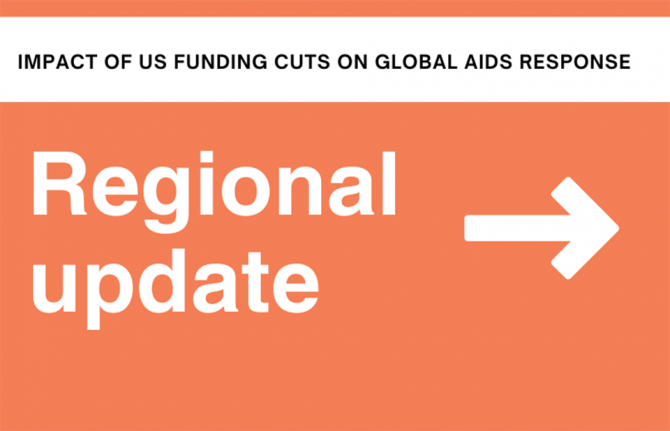
Feature Story
Impact of US funding cuts on HIV programmes in Latin America and the Caribbean
19 March 2025
19 March 2025 19 March 2025Current Situation
Prevention of HIV and other sexually transmitted infections among key populations in Latin America and the Caribbean is heavily reliant on US funding. Recent decisions by the United States Government indicate that efforts to support prevention among key populations will not receive funding resources. This has led to significant disruptions in and challenges for HIV services in the region.
Immediate risks and disruptions
- Humanitarian assistance: Transnational projects aimed at migrant populations have been suspended. Despite a waiver announced on February 1 allowing continued provision of some HIV services, resumption of humanitarian services has been hindered due to the absence of PEPFAR and USAID staff.
- Service delivery: The suspension of US funding has affected the delivery of various HIV services, including those provided by civil society organizations, government entities, and United Nations agencies. NGOs are particularly vulnerable to the US funding cuts.
- Impact on key populations: The US funding cuts have led to stress, depression, anxiety, and uncertainty among people living with HIV and key populations. There is a significant concern about the risk of being left without antiretroviral treatment, access to PrEP, and other essential services.
- Funds allocated for non-contingency humanitarian assistance were primarily focused on the humanitarian crises in Haiti and Venezuela, Colombia's post-conflict challenges, and the Northern Triangle crisis (Guatemala, Honduras, El Salvador). Although these funds were not intended for a direct response to HIV, their absence deepens the structural vulnerability of migrant and other vulnerable populations—including people affected by conflict in Colombia—and puts them at risk of exploitation, human trafficking and survival sex, all of which increase vulnerability to HIV.
Politically relevant updates
- Emergence of extreme positions: In many countries in the region, outbursts of homophobia, transphobia and discrimination against people living with HIV have intensified. Many parliamentarians in the region have taken advantage of the situation to gain political leverage by attacking key populations.
- Media Representation: Actions targeting societal enablers are being shown in the media as examples of waste of money and corruption.
Civil society impact and resilience:
- Survey Findings: A survey conducted by the civil society organization "Corresponsales Clave" (Key Correspondents) with 49 organizations from various countries in the region revealed that US funding cuts have led to significant disruption of services for key populations and emotional distress among people living with HIV and key populations.
- Community Response: Despite the challenges, civil society organizations and community leaders are working to ensure the sustainability of the HIV response by optimizing health services.
- UN Response: The offices of the UN Resident Coordinators are intensifying the search for non-traditional donors and making bilateral approaches with embassies to identify funding opportunities. UNAIDS and PAHO are working together to deliver technical assistance to optimize health services in three areas: integration of HIV services in primary health care, optimization of service delivery models, and facilitation of community response to HIV.
- UNAIDS is carrying out joint analyses with the Global Fund to align the resources of national grants destined to the strengthening and resilience of health e-services with the principles mentioned above.
Additional Insights
- Regional Progress: The Caribbean has made substantial progress against HIV since 2010, with a 22% decrease in new HIV infections and a 57% decrease in AIDS-related deaths. Latin America is the most autonomous region of the Global South in terms of national funding for HIV treatment, but there are still major gaps in prevention and social enablers. Therefore, continued funding is a necessary strategy for a smooth transition towards full sustainability of the HIV response in the region.
- Funding Challenges: The critical impact of the US funding cuts has exacerbated existing challenges in the HIV response across Latin America and the Caribbean.
Related resources
Related


Feature Story
Impact of US funding cuts on HIV programmes in Vietnam
19 March 2025
19 March 2025 19 March 2025Current Coverage and Services
- Pre-exposure Prophylaxis (PrEP): According to the National AIDS authority, as of January 31, 2025, there are 210 health facilities nationwide providing PrEP services, with 44,780 people using the service. Of these, 92 facilities with 31,639 clients (70.7%) are funded by PEPFAR in 11 provinces. Antiretrovirals for PrEP committed by PEPFAR in COP 2024-2025 have been delivered by one third. Current stock can cover for PEPFAR-supported PrEP clients until end of May 2025. Relevant medical facilities supported by US CDC have resumed full package service, while those supported by USAID only provide PrEP medicines from available PEPFAR stock but do not cover associated costs, which fall on patients paying out-of-pocket. The development and implementation of the AIDS Information Management System, including PrEP management system, is on hold.
- Antiretroviral Treatment (ART): ART is mainly financed by social health insurance funds and partially by the Global Fund. Technical assistance to the supply chain and treatment information system, mostly through USAID, has been affected.
- HIV Testing and Treatment: Community outreach and lay testing have been heavily affected. All treatment facilities and service points are operating at full capacity. Prevention of vertical transmission and pediatric services are also functioning without disruption.
- Supplies: ARV supplies, HIV tests, viral load tests, and condoms are available with minimal disruption. According to the Viet Nam Administration of Disease Prevention, PEPFAR committed to support about 40,000 PrEP clients in 2025. The Global Fund is supporting 23,000 PrEP clients in 2025 and 25,000 in 2026.
Immediate Risks and Disruptions
- Funding Freeze: The freeze on PEPFAR funding has significantly impacted the expansion of PrEP coverage. This has led to disruptions in access to PrEP and reduced capacity for HIV prevention services, particularly affecting men who have sex with men, and transgender people.
- Stigma and Discrimination Programs: Almost all PEPFAR supported initiatives addressing stigma and discrimination have been halted and those allowed to continue with support through US CDC are requested to not refer to transgender persons and other key populations, which could exacerbate challenges faced by key populations.
- Civil Society Organizations (CSOs): There has been a reduction or suspension of services provided by CSOs, limiting their ability to participate in essential HIV services, policy discussions, data collection and reporting, and access to government or donor support.
Politically Relevant Updates
- Government Response: The Vietnamese government, through the Viet Nam Administration of Disease Prevention, has formed an informal task team to receive feedback from organizations of people living with HIV and key populations.
- Precise numbers of the affected CBO community workers are not available. The government is not assuming the costs for the community workers affected by the PEPFAR freeze.
- International Support: The US funding cut has led to the suspension and/or termination of USAID-funded projects, including critical healthcare programs for tuberculosis and HIV prevention and strengthening of systems for health/HIV. Despite these challenges, the Vietnamese government remains committed to prioritizing resources and implementing effective measures for HIV prevention and control.
Related resources
Region/country


Feature Story
Impact of US funding cuts on HIV programmes in Uganda
19 March 2025
19 March 2025 19 March 2025Immediate Risks and Disruptions
- Distribution Disruptions:
- According to the policy brief to Parliament prepared by the Uganda AIDS Commission with support from UNAIDS, stocks of ARV supplies, HIV, viral load and other lab test kits are available. However, distribution from district hubs to lower health facilities is disrupted due to reliance on US-funded implementing partners. Facilities have adequate stocks for three months, but the impact will be felt from the second quarter of 2025 if not mitigated.
- Condom stockouts are anticipated within the next 3-6 months due to challenges with last mile distribution.
- Service Capacity:
- All ART-providing facilities are operating at reduced capacity. Some community-led, peer-led, NGO-run, and private facilities have stopped services.
- Reduced adherence to prevention of vertical transmission and early infant diagnosis services due to decreased numbers of expert clients and mentor mothers.
- HIV prevention services for key populations at drop-in centres, including PrEP access, HIV testing, and antiretroviral treatment adherence counselling for sex workers, men who have sex with men, transgender persons, people who use drugs, and prisoners, have been disrupted.
- Human Resources:
- It is unclear whether US-funded health workers will be integrated into the government payroll.
- Data clerks at facilities covered by USAID are not yet back at work, impacting data collection and quality control.
Politically Relevant Updates
- Government Actions:
- The Ugandan President directed the release of UGX 6 billion for the rollout of electronic medical records (EMR) in government health facilities to improve service delivery.
- The Ministry of Health issued guidance on improving service delivery, including integrating HIV, TB, and other chronic disease services, training health workers in integrated service delivery, prioritizing recruitment of critical staff, utilization of primary health care funds for disease prevention outreach activities and strengthening accountability for medicines and laboratory supplies.
- Mitigation Measures:
- The government is reallocating domestic resources to priority HIV programs and integrating HIV services into other health services.
- Civil society partners have conducted rapid assessments to understand the impact of the US Government funding cuts on service delivery.
- Human Rights and Key Populations:
- US funding for stigma, discrimination, and enabling legal environments has stopped, and no alternative funding has been found.
- Communities are not collecting data on human rights issues, including increased stigma and discrimination.
- Key populations groups have conducted a rapid assessment on the impact of the US funding cuts. There is also ongoing work to conduct an assessment with people living with HIV and key populations-related services at drop-in centres.
Related resources
Region/country


Feature Story
Impact of US funding cuts on HIV programmes in Rwanda
18 March 2025
18 March 2025 18 March 2025General Overview
- Funding: Rwanda's HIV program is predominantly donor-funded. In fiscal year 2023-2024, PEPFAR contributed 37.7% of the total HIV expenditure and the Global Fund contributed 50.8%. There is minimal involvement of domestic private contributors in the HIV response.
- Continuity of Services: The Ministry of Health is the principal recipient of PEPFAR funding. During early days of the Stop Work Order by the US Government, the Government of Rwanda through the Ministry of Health ensured the continuity of essential services and effective implementation of the waivers. Furthermore, the Ministry of Health has committed to mobilizing domestic resources to ensure the continuity of HIV services. All facilities/service points providing antiretroviral therapy (ART) are operating at full capacity. Peadiatric HIV treatment services and data collection activities continue without disruption.
- Supplies and Distribution: Stocks of antiretroviral (ARV) supplies, viral load (VL) test kits, and other lab test kits are available with minimal distribution disruptions. No stockouts are expected in the next 3-6 months. The country has a sufficient stock of condoms for the next 12 months.
Immediate Risks or Disruptions
- Community-Led Services: Some community-led or peer-led facilities and services have been suspended. For example, a local NGO has closed its clinic which provided free and friendly key population services, including sexually transmitted infections testing and treatment.
Though some previously USAID supported DREAMS projects targeting adolescent girls and young women and orphan and vulnerable children (3 out of 5) have received notification to resume work, activities have not fully started due to operational challenges.
- Community-Led Monitoring (CLM): Rwanda received PEPFAR funding for a CLM project to assess the 4As for quality delivery of services including availability, accessibility, acceptability and affordability of services by people living with HIV and key population. That work has now stopped, and communities have suspended data collection on these issues, including stigma and discrimination at service delivery points.
Politically Relevant Updates
- Government and Partners’ Actions: The government, in collaboration with partners, is conducting a rapid assessment of the impact of shifts in US Government funding, with technical support from UNAIDS. Civil society organizations (CSOs) are encouraged to document facility level as well as community supported services delivery gaps and coverage for use in advocacy and resource mobilization.
- Press Conference: During a press conference, the Ministry of Health reaffirmed its commitment to mobilize domestic resources to ensure service continuity.
- Civil Society Organizations (CLOs): CLOs involved in service delivery at community level, particularly prevention and support for ensuring continuity have faced significant challenges, including increased demand with fewer resources, anxiety about continuity and future support, loss of staff, and funding cuts.
- Resilience and Response: Despite these challenges, CLOs continue to play a crucial role in the HIV response. Their resilience and adaptability in the face of funding cuts and service disruptions highlight the importance of community-led initiatives in maintaining essential health services.
UN response
- UNAIDS is supporting the government to assess the overall cost, priority and impact of the stopped interventions to inform actions. UNAIDS is reaching out separately to community networks and NGOs to collect more information about the impact of the US Government cuts.
Related resources
Region/country
Related


Feature Story
Impact of US funding cuts on HIV programmes in Lesotho
17 March 2025
17 March 2025 17 March 2025Current Status
- USAID Projects: Two projects funded by the US Government have received full activation notices; one focused on orphans and vulnerable children (in all 10 districts) and DREAMS (in 4 districts) and another focused-on treatment and care in 2 districts.
- CDC Projects: All CDC projects have received full activation notices.
- Other USAID Implementing Partners: Projects focused on key populations (KPs), voluntary medical male circumcision (VMMC), pre-exposure prophylaxis (PrEP), and a large project on treatment and care and health systems strengthening (HSS) are still terminated.
- Overall: Approximately 28% of PEPFAR support has resumed, 32% is still paused and 40% is terminated.
- Of the 1,508 human resources for health supported through PEPFAR funding, 804 (53.3%) are currently terminated
Immediate Risks and Disruptions
- Frequent Changes in Project Status: The frequent changes in the status of US Government-funded projects have caused delays in the activation process.
- Termination Notices: Some USAID implementing partners have received termination notices, causing disruptions in services.
Government Actions
- Task Team: Led by the Ministry of Health and operational since January 27, the task team is mapping out affected US-funded projects and identifying mitigation measures, including government payment of salaries for essential staff, task shifting, recalling staff on leave, and integration of health workers' roles. The immediate priorities of the Ministry of Health and National AIDS Commission are to ensure commodity security, to lead and coordinate through convening task team meetings and expediting development of Part B of the HIV and TB Sustainability Roadmap
- Funding Decisions: Ministry of Health submitted a contingency budget to the Ministry of Finance and Development Planning to cover salaries at government salary scale for critical staff for three months. For the medium term, government and partners are waiting until the end of the US Government review period (April 20) to make significant funding allocation decisions.
Civil Society Response
- Joint Press Statement: Civil society partners, supported by UNAIDS, issued a statement calling for government support and acceleration of social contracting.
- Impact on Civil Society: Some CSOs are receiving activation notices, while others, like LENEPHWA (network of people living with HIV), remain under termination.
UN Response
- UNAIDS is collaborating with the Government to plan mitigation measures for service continuity, supporting civil society advocacy, and maintaining communication with PEPFAR, USAID, CDC, and USAID prime partners.
- UNAIDS is working with the National AIDS Commission and Ministry of Health to expediate development of HIV and TB Sustainability Roadmap Part B, with preparatory and analytical work while awaiting the global guidance.
- Regular Updates: UNAIDS has kept the Resident Coordinator (RC) and UN Country Team (UNCT) regularly updated, with the RC advocating for the establishment of an inter-ministerial task team to monitor the US Government funding situation.

